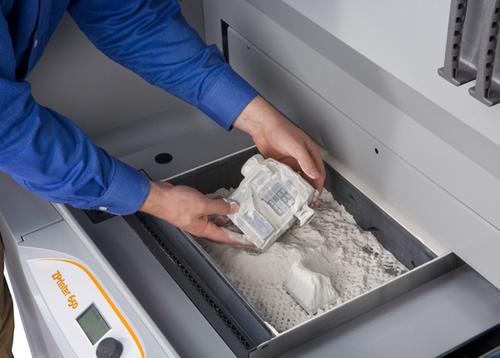
Dr. Tim Evans with his 3D-printed model of a forest fire. (Source: Imperial College London)
Posted on 12/10/2013 12:11:27 PM PST by null and void

Dr. Tim Evans with his 3D-printed model of a forest fire. (Source: Imperial College London)
Students may soon be able to reach out and touch some of the theoretical concepts they are taught in their physics classes thanks to a novel idea devised by a group of researchers from Imperial College London.
In a new study published in the journal EPL, the researchers have successfully demonstrated how complex theoretical physics can be transformed into a physical object using a 3-D printer.
In just eight hours and at the cost of around 15 euros, they were able to use a commercially available 3-D printer to create their own 8 cm3 object based on a mathematical model that described how forest fires can be started and how they eventually spread over time.
The researchers have labelled the approach "Sculplexity"—standing for sculptures of complexity—and believe it could also be used to produce works of art based on science, or transform the way that ideas and concepts are presented and discussed within the scientific community.
Co-author of the study Dr. Tim Evans, a theoretical physicist at Imperial, said: "The work was inspired by a visit to the Victoria and Albert Museum in London where I came across the first ever 3-D printed object the museum had acquired.
"The object was a table inspired by the tree-like structures found in nature, which is an example of a branching process that is commonly encountered in complex systems in theoretical physics. This led me to think, what other processes familiar to physics could be turned into a 3-D printed object?"
Complex systems are made up of many parts that interact on many time and length scales and which show coherent behavior and certain patterns on a large scale. A living organism is the best example of a complex system, whereby the individual parts—in this case the molecular processes in the cell — interact with each other and contribute to much larger processes on a macroscopic scale.
The interactions at play in many complex systems can be mapped out onto a two-dimensional grid which is divided into identical squares, or "cells". Each of the cells can exist in a certain state and evolve over time, which is governed by a certain set of rules.
In their study, the researchers used a forest fire as an example, in which each cell represented a tree which could either be alive, dead or burning. The exact state that each cell occupied over time depended on a set of rules, which took into account the cell's proximity to other cells that may be burning or if it was struck by lightning.
"The basic idea is simple," continued Evans. "A 3-D printer builds up its object in layers. So the height of the object can be thought of as time. Suppose you have a mathematical model which defines a flat, two-dimensional picture that evolves in time — typically this will be a grid with some squares full and some empty.
"The mathematical model will define at each point in time what the printer should print at one height. The next step in the model will then define what to print on top of the first layer, and so forth. The result is a 3-D object which shows how the mathematical model has evolved over time."
The resulting model the researchers created was not without glitches; however, Evans believes the experience has allowed them to identify the obstacles, formulate solutions and inspire the physics community to "get creative".
"In our own group at Imperial we are trying to explain heartbeat anomalies by looking at simple models for the behavior of individual cells in heart muscle — it's possible that this could be visualized using 3-D printing. Most models that represent the spread of disease could also be visualized.
"There may be many other examples and we just hope our rather literal translation from theoretical model to 3-D printer output stimulates others to get creative," Evans concluded.

Political power grows out of the nozzle of a 3-D Printer.
Possibly of particular interest to you...
So there’s no other way to make visual aids for scientific
Show and Tells?
Measurements of dozens of real rivers, and computer simulations of many more, show that the relationship between their shortest path across a plain, and their actual length is always the same. It is Pi, the ratio between the circumference of a circle and its diameter.
Nope. This is the only way to do it.
The marriage of preexisting technologies. Using a 3-D printer to make plastic toys of his favorite objects (solutions to numerical simulations).
Sure, they could use ping pong balls, bendie straws, and rubber bands, but this is much cooler.

Not yet...
Because...it wouldn’t be printing.
Hey thanks. Kewl.
Disclaimer: Opinions posted on Free Republic are those of the individual posters and do not necessarily represent the opinion of Free Republic or its management. All materials posted herein are protected by copyright law and the exemption for fair use of copyrighted works.